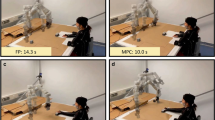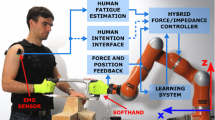Abstract
Collaborative robots (cobots) have the potential to augment the productivity and life quality of human operators in the context of Industry 4.0 by providing them with physical assistance. For this reason, it is necessary to define the relationship between humans and cobots and to study how the two agents adapt to each other. However, to the best of our knowledge, literature is still missing insight into how humans perceive and react to changes in the cobot behavior (e.g. changes in the learned trajectory and in the role the robot assumes). Specifically, a study of how humans adapt to changing roles and control strategies of collaborating robots is missing. To fill this gap, we propose a human study in which 16 participants executed a collaborative human–robot sawing task where the cobot altered between three different control strategies. We examined human adaptation when cobot suddenly changed the control strategy from one to another, resulting in six experimental conditions. The experiments were performed on a setup involving Kuka LBR iiwa robotic arm. The results suggest that transition influences movement performance in the early stages and at steady state, subjects prefer to abandon modes that require more effort and they adapt faster to energy-demanding modes. Finally, for the specific task we studied, subjects tend to prefer collaborative modes to ones in which the robot assumes a fixed role.







Similar content being viewed by others
References
Agravante, D. J., Cherubini, A., Sherikov, A., et al. (2019). Human-humanoid collaborative carrying. IEEE Transactions on Robotics, 35(4), 833–846.
Ajoudani, A., Fang, C., Tsagarakis, N., et al. (2018). Reduced-complexity representation of the human arm active endpoint stiffness for supervisory control of remote manipulation. The International Journal of Robotics Research, 37(1), 155–167.
Ajoudani, A., Zanchettin, A. M., Ivaldi, S., et al. (2018). Progress and prospects of the human-robot collaboration. Autonomous Robots, 42(5), 957–975.
Albu-Schaffer, A., Ott, C., Frese, U., et al. (2003). Cartesian impedance control of redundant robots: recent results with the dlr-light-weight-arms. In 2003 IEEE International conference on robotics and automation (Cat. No. 03CH37422) (pp. 3704–3709). IEEE.
Aronson, E., & Linder, D. (1965). Gain and loss of esteem as determinants of interpersonal attractiveness. Journal of Experimental Social Psychology, 1(2), 156–171.
Bednarczyk, M., Omran, H., & Bayle, B. (2022). Emg-based variable impedance control with passivity guarantees for collaborative robotics. IEEE Robotics and Automation Letters, 7(2), 4307–4312.
Bracewell, R. N., & Bracewell, R. N. (1986). The Fourier transform and its applications (Vol. 31999). McGraw-Hill.
Cacace, J., Caccavale, R., Finzi, A., et al. (2022). Combining human guidance and structured task execution during physical human–robot collaboration. Journal of Intelligent Manufacturing, 1–15.
Chen, K., Fong, J., Soh, H., et al. (2022). Mirror: differentiable deep social projection for assistive human-robot communication. arXiv preprint arXiv:2203.02877.
Chen, M., Nikolaidis, S., Soh, H., et al. (2020). Trust-aware decision making for human-robot collaboration: Model learning and planning. ACM Transactions on Human-Robot Interaction (THRI), 9(2), 1–23.
Cherubini, A., Passama, R., Crosnier, A., et al. (2016). Collaborative manufacturing with physical human-robot interaction. Robotics and Computer-Integrated Manufacturing, 40, 1–13.
De Luca, A., Albu-Schaffer, A., Haddadin, S., et al. (2006). Collision detection and safe reaction with the DLR-III lightweight manipulator arm. In 2006 IEEE/RSJ International Conference on Intelligent Robots and Systems (pp. 1623–1630). IEEE.
Dixon, W. J., & Massey, J. J. (1951). Introduction to statistical analysis (2nd ed.). McGraw-Hill.
Dong, J., Xu, J., Zhou, Q., et al. (2020). Physical human-robot interaction force control method based on adaptive variable impedance. Journal of the Franklin Institute, 357(12), 7864–7878.
El Makrini, I., Van De Perre, G., Mathijssen, G., et al. (2019). Improving user ergonomics through adaptable cobot behaviour–part 1–a generic algorithm for the computation of optimal ergonomic postures. IROS, 2019, 1–4.
Erden, M. S., & Billard, A. (2015). Hand impedance measurements during interactive manual welding with a robot. IEEE Transactions on Robotics, 31(1), 168–179.
Faccio, M., Granata, I., Menini, A., et al. (2023a). Human factors in cobot era: A review of modern production systems features. Journal of Intelligent Manufacturing, 34(1), 85–106.
Faccio, M., Granata, I., Minto, R., et al. (2023b). Task allocation model for human-robot collaboration with variable cobot speed. Journal of Intelligent Manufacturing, 1–14.
Fani, S., Ciotti, S., Catalano, M. G., et al. (2018). Simplifying telerobotics: Wearability and teleimpedance improves human-robot interactions in teleoperation. IEEE Robotics Automation Magazine, 25(1), 77–88.
Fitts, P. M. (1951). Human engineering for an effective air-navigation and traffic-control system. Defense Technical Information Center.
Gallina, P., Bellotto, N., & Di Luca, M. (2015). Progressive co-adaptation in human-machine interaction. In 2015 12th International Conference on Informatics in Control, Automation and Robotics (ICINCO) (pp. 362–368). IEEE.
Gribble, P. L., Mullin, L. I., Cothros, N., et al. (2003). Role of cocontraction in arm movement accuracy. Journal of Neurophysiology, 89(5), 2396–2405.
Hogan, N. (1984). Impedance control of industrial robots. Robotics and Computer-Integrated Manufacturing, 1(1), 97–113.
Ikemoto, S., Amor, H. B., Minato, T., et al. (2009). Physical interaction learning: behavior adaptation in cooperative human-robot tasks involving physical contact. In RO-MAN 2009-The 18th IEEE International Symposium on Robot and Human Interactive Communication (pp. 504–509). IEEE.
Jarrassé, N., Charalambous, T., Burdet, E., et al. (2012). A framework to describe, analyze and generate interactive motor behaviors. PLoS ONE, 7(11), e49945.
Jarrasse, N., Sanguineti, V., & Burdet, E. (2014). Slaves no longer: Review on role assignment for human-robot joint motor action. Adaptive Behavior, 22(1), 70–82.
Kheddar, A. (2011). Human-robot haptic joint actions is an equal control-sharing approach possible? In 2011 4th International Conference on Human System Interactions, HSI 2011 (pp. 268–273). IEEE.
Khoramshahi, M., & Billard, A. (2020). A dynamical system approach for detection and reaction to human guidance in physical human-robot interaction. Autonomous Robots, 44(8), 1411–1429.
Kumar, S., Savur, C., & Sahin, F. (2020). Survey of human-robot collaboration in industrial settings: Awareness, intelligence, and compliance. IEEE Transactions on Systems, Man, and Cybernetics: Systems, 51(1), 280–297.
Li, Y., Tee, K. P., Chan, W. L., et al. (2015). Continuous role adaptation for human-robot shared control. IEEE Transactions on Robotics, 31(3), 672–681.
Liu, Y., Leib, R., Dudley, W., et al. (2022). The role of haptic communication in dyadic collaborative object manipulation tasks. arXiv preprint arXiv:2203.01287.
Losey, D. P., McDonald, C. G., Battaglia, E., et al. (2018). A review of intent detection, arbitration, and communication aspects of shared control for physical human–robot interaction. Applied Mechanics Reviews, 70(1).
Maddikunta, P. K. R., Pham, Q. V., B P, et al. (2022). Industry 5.0: A survey on enabling technologies and potential applications. Journal of Industrial Information Integration, 26, 100257.
Maurice, P., Allienne, L., Malaisé, A., et al. (2018). Ethical and social considerations for the introduction of human-centered technologies at work. In 2018 IEEE Workshop on Advanced Robotics and its Social Impacts (ARSO) (pp 131–138).
Maurice, P., Malaisé, A., Amiot, C., et al. (2019). Human movement and ergonomics: An industry-oriented dataset for collaborative robotics. The International Journal of Robotics Research, 38(14), 1529–1537.
Nakamura, Y., & Umemuro, H. (2022). The effect of robots listening attitude change on the self-disclosure of the elderly: a preliminary study. In Proceedings of the 2022 ACM/IEEE International Conference on Human-Robot Interaction (pp. 932–936).
Nardo, M., Forino, D., Murino, T., et al. (2020). The evolution of man-machine interaction: The role of human in industry 4.0 paradigm. Production & Manufacturing Research, 8(1), 20–34.
Nemlekar, H., Modi, J., Gupta, S. K., et al. (2021). Two-stage clustering of human preferences for action prediction in assembly tasks. arXiv preprint arXiv:2103.14994.
Ngoc, H. N., Lasa, G., & Iriarte, I. (2022). Human-centred design in industry 4.0: Case study review and opportunities for future research. Journal of Intelligent Manufacturing, 33, 35–76.
Nikolaidis, S., Hsu, D., & Srinivasa, S. (2017). Human-robot mutual adaptation in collaborative tasks: Models and experiments. The International Journal of Robotics Research, 36(5–7), 618–634.
Nikolaidis, S., & Shah, J. (2013). Human-robot cross-training: computational formulation, modeling and evaluation of a human team training strategy. In 2013 8th ACM/IEEE International Conference on Human-Robot Interaction (HRI) (pp. 33–40). IEEE.
Peternel, L., Noda, T., Petrič, T., et al. (2016). Adaptive control of exoskeleton robots for periodic assistive behaviours based on EMG feedback minimisation. PLoS ONE, 11(2), e0148942.
Peternel, L., Kim, W., Babič, J., et al. (2017a). Towards ergonomic control of human-robot co-manipulation and handover. In 2017 IEEE-RAS 17th International Conference on Humanoid Robotics (Humanoids) (pp. 55–60). IEEE.
Peternel, L., Tsagarakis, N., & Ajoudani, A. (2017b). A human-robot co-manipulation approach based on human sensorimotor information. IEEE Transactions on Neural Systems and Rehabilitation Engineering, 25(7), 811–822.
Peternel, L., Tsagarakis, N., Caldwell, D., et al. (2018). Robot adaptation to human physical fatigue in human-robot co-manipulation. Autonomous Robots, 42(5), 1011–1021.
PP, R. (1964). Human experimentation. code of ethics of the world medical association. Declaration of Helsinki. British Medical Journal, 2(5402), 177–177.
Rahal, R., Matarese, G., Gabiccini, M., et al. (2020). Haptic shared control for enhanced user comfort in robotic telemanipulation. In SALC 2020-IEEE ICRA workshop on Shared Autonomy: Learning and Control (pp. 1–2). IEEE.
Robert, L. (2018). Personality in the human robot interaction literature: a review and brief critique. In Robert, L. P. (Ed.), Personality in the human robot interaction literature: A review and brief critique, Proceedings of the 24th Americas Conference on Information Systems (pp. 16–18).
Saunderson, S., & Nejat, G. (2022). Hybrid hierarchical learning for adaptive persuasion in human-robot interaction. IEEE Robotics and Automation Letters, 7(2), 5520–5527.
Selvaggio, M., Cognetti, M., Nikolaidis, S., et al. (2021). Autonomy in physical human-robot interaction: A brief survey. IEEE Robotics and Automation Letters, 6(4), 7989–7996.
Shafti, A., Tjomsland, J., Dudley, W., et al. (2020). Real-world human-robot collaborative reinforcement learning. In 2020 IEEE/RSJ International Conference on Intelligent Robots and Systems (IROS) (pp. 11161–11166). IEEE.
Van Der Laan, J. D., Heino, A., & De Waard, D. (1997). A simple procedure for the assessment of acceptance of advanced transport telematics. Transportation Research Part C: Emerging Technologies, 5(1), 1–10.
Vianello, L., Gomes, W., Maurice, P., et al. (2022). Cooperation or collaboration? on a human-inspired impedance strategy in a human-robot co-manipulation task. \(\langle \text{hal-03589692}\rangle \).
Wang, J., & Li, Y. (2010). Hybrid impedance control of a 3-dof robotic arm used for rehabilitation treatment. In 2010 IEEE International Conference on Automation Science and Engineering (pp. 768–773).
Wilcox, R., Nikolaidis, S., & Shah, J. (2013). Optimization of temporal dynamics for adaptive human-robot interaction in assembly manufacturing. Robotics, 8, 441.
Ye, C., Yang, J., & Ding, H. (2020). Bagging for gaussian mixture regression in robot learning from demonstration. Journal of Intelligent Manufacturing, 33, 867–879.
Funding
Funding was provided by Université de Lorraine.
Author information
Authors and Affiliations
Corresponding author
Ethics declarations
Conflict of interest
The authors declare no conflict of interest.
Ethical approval
All procedures performed in studies involving human participants were in accordance with the ethical standards of the TU-Delft’s ethical committee and with the 1964 Helsinki declaration and its later amendments or comparable ethical standards.
Informed consent
All the participants involved in the experiments signed an informed consent form to participate in the study.
Additional information
Publisher's Note
Springer Nature remains neutral with regard to jurisdictional claims in published maps and institutional affiliations.
Rights and permissions
Springer Nature or its licensor (e.g. a society or other partner) holds exclusive rights to this article under a publishing agreement with the author(s) or other rightsholder(s); author self-archiving of the accepted manuscript version of this article is solely governed by the terms of such publishing agreement and applicable law.
About this article
Cite this article
Vianello, L., Ivaldi, S., Aubry, A. et al. The effects of role transitions and adaptation in human–cobot collaboration. J Intell Manuf (2023). https://doi.org/10.1007/s10845-023-02104-5
Received:
Accepted:
Published:
DOI: https://doi.org/10.1007/s10845-023-02104-5




